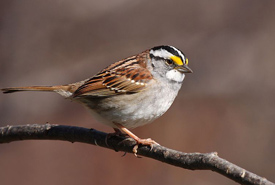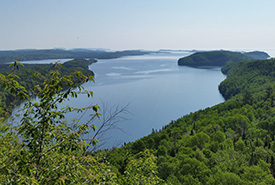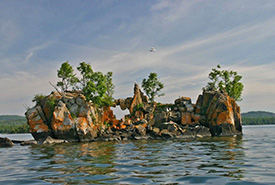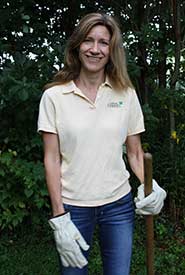Song of Northern Superior

White-throated sparrow (Photo by Wikimedia Commons)
It was a chilly April morning in southern Ontario, so all of the windows in my house were closed. But I could still hear something outside. I quickly pushed open the window and listened. There it was — the cheery song of the white-throated sparrow: “pure, sweet, Canada Canada Canada.” He was acknowledging that he was here, on a brief rest stop near the north shore of Lake Erie, but most certainly with a more northern destination in mind.

Looking down over Big Trout Bay, Lake Superior, ON (Photo by NCC)
As he called, I was immediately transported back in time. I always associate the white-throated sparrow’s sweet song with wilderness camping in northern Ontario. I recall many mornings from my youth of waking up with the sun beating down on our orange canvas tent and the sparrow singing from a tree branch above. I would pull on the tent’s thick zipper to reveal large, flat rocks and a glistening lake just steps away. Big, flat, solid rocks. So solid and unmovable that you couldn’t help but feel safely anchored to Earth’s ancient crust.
Recently, the Nature Conservancy of Canada (NCC) has been spending a lot of time focused on the wilderness landscape of Lake Superior’s north shore, quite possibly where my sparrow friend was headed. Just recently, NCC acquired 2,500 acres (1,000 hectares) of coastal boreal forest with 21 kilometres of shoreline, including stretches of open bedrock, cobble beach and spectacular cliff outcrops.
The property, known as Big Trout Bay Nature Reserve, is just north of the United States border and about half an hour from Thunder Bay. It offers valuable habitat for songbirds and is large and connected enough to support wide-ranging mammals, such as eastern wolf, Canada lynx and wolverine.
Lake Superior’s north shore is the last of the Great Lakes wilderness shoreline. Fortunately, there’s still time to ensure this rugged shoreline remains wild for the long term. NCC is playing a lead role in this effort and conserving Big Trout Bay Nature Reserve is a big step forward — a big step made possible by partners and supporters on both sides of the border, including our American friends at The Conservation Fund, The Nature Conservancy’s Wisconsin and Minnesota chapters and a number of very generous U.S. donors.

Rock formation on the north shore of Lake Superior, ON (Photo by Carol DeSain)
Lately I’ve been thinking a lot about the north while working with my colleagues on this project. I grew up just outside Thunder Bay, so the area is dear to me. Camping and canoeing is how I spent a lot of my free time with family and friends.
Coincidentally, my mother recently shared my grandfather’s scrapbook with me. He died when I was eight so I didn’t know him well. But it turns out, A.S.L. Barnes was an active conservationist in Ontario back in the 1950s and ‘60s and held the post of director of the conservation authorities for eight years.
What struck me while flipping through the scrapbook was that after he retired in 1970, he became the executive secretary of the Quetico Foundation. The article goes on to describe the foundation as dedicated to the preservation of wilderness areas, particularly in northern Ontario.
Well Grandad, you’d be happy to know that we have a great team assembled, including partners and friends on both sides of the U.S-Canadian border. We are on the path to achieving our ambitious vision of conserving the last Great Lakes wilderness shoreline. More than 40 years later, your good work lives on with the Big Trout Bay Nature Reserve.
As for my white-throated sparrow, perhaps he will spend the summer at Big Trout Bay Nature Reserve, staking out territory, fathering a few chicks and then fattening up on boreal seeds and insects in preparation for his trip south. One thing is certain; next year his summer home will be there when he returns.
NCC is very grateful for the generous support of Big Trout Bay Nature Reserve. Learn more about NCC’s work on the north shore of Lake Superior here.


